Uncovering the Unique Characteristics of Fresh Strawberries
Identifying the Perfect Strawberry: A Visual Guide
When shopping for strawberries, it’s essential to know what to look for to ensure you’re getting the best quality. But what does strawberry look like, exactly? A fresh strawberry should have a vibrant red color, a plump shape, and a sweet aroma. The texture should be firm but yielding to the touch. In this article, we’ll explore the unique characteristics of fresh strawberries, from their shape and size to their color and texture. We’ll also cover how to recognize a ripe strawberry, the different parts of a strawberry, and the various types of strawberries available. By the end of this guide, you’ll be able to identify the perfect strawberry every time.
How to Recognize a Ripe Strawberry
Choosing a ripe strawberry can be a challenge, but it’s crucial to get it right. A ripe strawberry is sweet, juicy, and bursting with flavor. So, what does strawberry look like when it’s ripe? A ripe strawberry will typically have a deep red color, with no white or green spots. The skin should be slightly soft to the touch, but still firm enough to hold its shape. The stem should come off easily, and the strawberry should have a sweet, fruity aroma. When selecting strawberries at the store or farmer’s market, gently squeeze the fruit to check for ripeness. Avoid strawberries with bruises, mold, or soft spots, as these can be signs of spoilage. By following these tips, you’ll be able to choose the perfect, ripe strawberry every time.
The Anatomy of a Strawberry: Understanding its Parts
When it comes to understanding what a fresh strawberry looks like, it’s essential to know the different parts that make up this delicious fruit. A strawberry consists of several key components, each playing a crucial role in its overall appearance and quality. The calyx, a green leafy structure, sits atop the strawberry and serves as a protective covering. The stem, a small, white, and tender part, connects the strawberry to the plant. The seeds, tiny and scattered throughout the fruit, provide a subtle crunch and added nutrition. The flesh, the edible part of the strawberry, is made up of tiny, juicy sacs that burst with flavor when bitten into. By understanding the anatomy of a strawberry, you’ll be better equipped to identify a fresh, high-quality strawberry and appreciate its unique characteristics.
Strawberry Varieties: Exploring the Different Types
When it comes to understanding what a fresh strawberry looks like, it’s essential to know about the various types of strawberries available. There are three main varieties of strawberries: June-bearing, ever-bearing, and day-neutral. June-bearing strawberries are the most common type and produce large, sweet berries in the summer months. Ever-bearing strawberries produce smaller berries throughout the growing season, while day-neutral strawberries produce berries continuously, regardless of daylight hours. Each variety has its unique characteristics, such as size, color, and flavor. For example, June-bearing strawberries are typically larger and sweeter, while ever-bearing strawberries are smaller and more tart. Day-neutral strawberries are often a combination of both. By understanding the different types of strawberries, you’ll be better equipped to identify what a fresh strawberry looks like and choose the perfect one for your needs.
What to Look for in Organic vs. Non-Organic Strawberries
When it comes to choosing the perfect strawberry, understanding the differences between organic and non-organic options is crucial. Organic strawberries are grown without the use of synthetic pesticides, fertilizers, or genetically modified organisms (GMOs). They tend to have a more vibrant color, a sweeter taste, and a higher nutritional content compared to non-organic strawberries. Non-organic strawberries, on the other hand, may have a longer shelf life due to the use of preservatives and may be more affordable. However, they may contain residues of pesticides and have a lower nutritional value. When selecting organic strawberries, look for the “USDA Organic” label or check with the farmer’s market vendor to ensure they follow organic farming practices. For non-organic strawberries, check the packaging for any certifications or labels indicating the use of sustainable farming practices. By understanding the differences between organic and non-organic strawberries, you’ll be able to make an informed decision and choose the best option for your needs, ultimately knowing what a fresh strawberry looks like and how to choose the perfect one.
Common Defects and Imperfections in Strawberries
When selecting fresh strawberries, it’s essential to be aware of common defects and imperfections that can affect their quality and appearance. Bruising, mold, and insect damage are some of the most common issues that can affect strawberries. Bruising can occur during handling or transportation, causing soft spots or discoloration on the fruit. Mold can develop on strawberries that are past their prime or have been stored improperly, resulting in a fuzzy white or green growth. Insect damage can occur when pests like aphids or whiteflies feed on the fruit, causing small holes or discoloration. To avoid these issues, inspect strawberries carefully before purchasing, looking for any signs of bruising, mold, or insect damage. Choose strawberries that are firm, plump, and have a vibrant color, knowing what a fresh strawberry looks like. Store strawberries properly in a cool, dry place, and handle them gently to prevent bruising. By being aware of these common defects and imperfections, you can make informed purchasing decisions and enjoy fresh, high-quality strawberries.
Preserving the Freshness of Strawberries: Tips and Tricks
To keep strawberries fresh for a longer period, it’s essential to store them properly. Store strawberries in a cool, dry place, away from direct sunlight and heat sources. Avoid washing strawberries before storing them, as excess moisture can lead to mold and spoilage. Instead, gently rinse strawberries just before using them. Pat dry strawberries with a clean towel or paper towels to remove excess moisture. Store strawberries in a breathable container, such as a paper bag or a ventilated plastic bag, to maintain air circulation. To extend the shelf life of strawberries, consider freezing them. Rinse and dry strawberries, then place them on a baking sheet and put them in the freezer. Once frozen, transfer strawberries to an airtight container or freezer bag for long-term storage. By following these tips and tricks, you can enjoy fresh strawberries for a longer period, knowing what a fresh strawberry looks like and how to preserve its freshness.
Conclusion: Mastering the Art of Strawberry Identification
In conclusion, understanding what a fresh strawberry looks like is crucial for making informed purchasing decisions and enjoying the best flavor and texture. By recognizing the key characteristics of a ripe strawberry, including its vibrant color, plump shape, and sweet aroma, you can choose the perfect strawberry every time. Additionally, being aware of common defects and imperfections, such as bruising and mold, can help you avoid spoiled strawberries. By following the tips and tricks outlined in this article, you can preserve the freshness of strawberries and enjoy them for a longer period. Remember, knowing what a fresh strawberry looks like is the key to unlocking the full flavor and nutritional potential of this delicious fruit. With practice and patience, you can become a strawberry connoisseur, able to identify the perfect strawberry with ease.





:max_bytes(150000):strip_icc()/Baskets-of-Strawberries-at-Market-57edf1b85f9b586c3599ff05.jpg)

/tips-for-better-strawberries-1401965-01-1623beb67f9e4200985ac03f07ffe7dc.jpg)